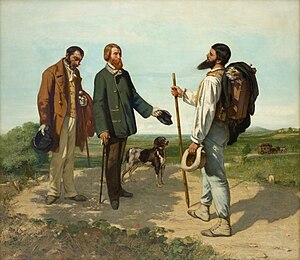La rencontre
| La rencontre, ou "Bonjour Monsieur Courbet" | |
|---|---|
 | |
| Artist | Gustave Courbet |
| Year | 1854 |
| Medium | Oil on canvas |
| Dimensions | 129 cm × 149 cm (51 in × 59 in) |
| Location | Musée Fabre, Montpellier |
The Meeting or "Bonjour, Monsieur Courbet" (French: La rencontre, ou "Bonjour Monsieur Courbet") is an oil-on-canvas painting by Gustave Courbet, made in 1854. It depicts the artist on his way to Montpellier meeting his patron Alfred Bruyas, his servant Calas, and his dog Breton. One of Courbet's most popular works, it also serves as one of the artist's most emblematic contributions to the 19th-century movement of Realism.[1]: 214 The composition is based on the myth of the Wandering Jew.[1]
History and description
[edit]The painting was commissioned by Alfred Bruyas from Gustave Courbet. This work immortalizes the arrival of Gustave Courbet in Montpellier in 1854. It also represents the meeting of the painter with the one who will become his patron, Alfred Bruyas. The painting is inspired by a popular print engraved by Pierre Leloup du Mans in 1831, named The bourgeois of the city talking to the wandering Jew. The Meeting was exhibited in Paris at the 1855 Exposition Universelle, where critics ridiculed it as "Bonjour, Monsieur Courbet". Bruyas did not exhibit The Meeting until he donated it to the Musée Fabre in Montpellier in 1868.[2]
The work depicts the scene taking place on a road between Saint-Jean de Védas and Mireval, when Alfred Bruyas, wealthy industrialist and art collector, accompanied by his valet and his dog, comes to meet Courbet. Surprisingly, the artist represents himself on the same social level as Bruyas.[3] He even appears proud and robust while the latter is depicted as puny and stuffy.[4]
References
[edit]- ^ a b AAVV, Gustave Courbet: Exhibition, Paris, New York, Montpellier 2007-2008, Paris, Meeting of National Museums, 2007
- ^ Hilaire, Michel; Amic, Sylvain (2004). Bonjour, Monsieur Courbet!: the Bruyas collection from the Musée Fabre, Montpellier. Réunion des musées nationaux, ISBN 978-0-300-10523-0
- ^ Smee, Sebastian (2024). Paris in Ruins: Love, War, and the Birth of Impressionism, p. 83. New York: W. W. Norton and Company. ISBN 978-1-324-00695-4
- ^ Sarah Lees, Bonjour, Monsieur Courbet!: The Bruyas Collection from the Musée Fabre, Montpellier, Yale University Press, 2004 ISBN 0-300-10523-1
External links
[edit]- Courbet's Bonjour Monsieur Courbet Archived 2014-10-22 at the Wayback Machine, essay at Smarthistory
